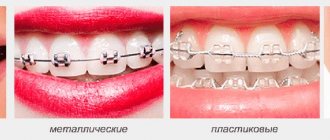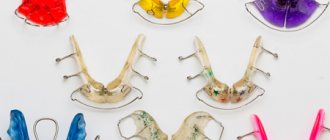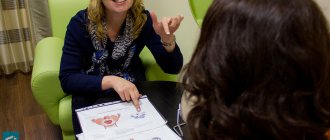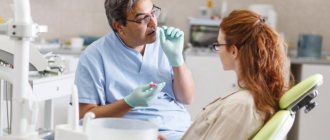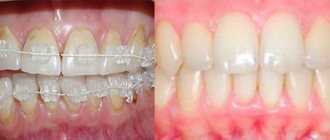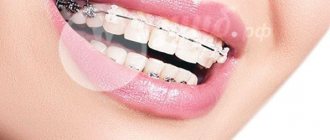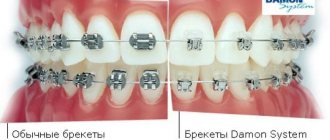An orthodontic plate is a special device necessary to correct the bite and teeth. The design includes the plate itself, a metal arc and fasteners. Metal parts are made of titanium and nickel alloy. The vestibular plate is made individually for each patient, based on the anatomical features of the jaw, the degree of curvature of the dentition and the desired result. The plate is made on the basis of previously taken impressions of the patient’s jaw.
Orthodontists at the 32 Dent clinic specialize in installing individual plates for the correction of pathologies in children and adults. Here we provide an integrated approach, clear control of the doctor, proper motivation, and a guarantee of results.
How does a vestibular plate work?
Each plate has a “memory”, thanks to which the metal arcs still return to their original positions. This is important in the process of correcting the bite, when the arch “moves” the patient’s jaw bones and teeth to the required correct parameters. The orthodontist’s task is to select a plate with metal elements of such thickness and tension force that it works effectively in each specific case.
The plate may also have a special “clasp” that corrects its position during the treatment period. The lock is tightened at certain intervals, thereby correcting the bite.
When is the record used?
- for the treatment of abnormal position of teeth (canines and incisors);
- to correct a situation where a patient has had a tooth removed that had erupted out of place;
- to obtain a healthy bite without removing healthy teeth.
Plates for teeth
A plate is a removable orthodontic appliance that is used to correct malocclusion in children aged 6 to 13 years. The main purpose of this device is to expand the dentition.
Expansion of the dentition occurs due to the gradual unwinding of the screw in the center of the structure
The plate has a plastic base that follows the shape of the palate and the inner surface of the teeth. One or more screws are placed in the center, due to which the correction will occur. Plates solve the most common problem of crowding of teeth due to lack of space in the child's jaw.
Correction needs to be done once every month and a half. The orthodontist will gradually unscrew the screw, each turn expanding the plate by 0.25 mm. As a rule, pressure on the jaw is felt in the first 5–15 minutes after correction.
The plate may also contain elements for correcting individual teeth, for example, to correct tilt or rotation.
The duration of treatment with plates is on average 1.5–2 years. They are worn, depending on the doctor’s recommendations, from 18 to 24 hours a day.
The plate is removed when eating and brushing teeth
Plates are individual devices that are made for each patient. Depending on the clinical cases, single-jaw or double-jaw systems are used: from the name it is clear that the former correct one jaw, the latter – both at once.
Plates can also be made with artificial teeth - they are necessary if, for some reason, the child has lost milk teeth early. Early tooth loss can cause malocclusion, for example, when neighboring teeth begin to take the place of the missing one, and over time there is no place for the molar to erupt.
Why do patients choose vestibular plates? Advantages and disadvantages of designs
Pros of orthodontic plates:
- The price is within reason.
Low cost compared to the same braces (the cost of the design ranges from 8,000 to 10,500 rubles per course of treatment);
- Easy to wear and hygienic.
The patient can easily remove it from the mouth before eating, wash it, and put on the device independently.
- Eat what you like.
When wearing plates, there are no restrictions on food consumption. You can eat meat, hard and sticky foods. The design is simply removed before eating and put on afterwards. - Correction of the position by a doctor or independently.
During dental treatment, you can always adjust the tension force. This can be done by the patient himself, tightening the lock, or by the dentist during a follow-up visit.
- Optimal aesthetics.
People around see only a metal arc on the teeth, and with close contact, the interlocutor practically does not notice the plate.
The nuances of using orthodontic plates for teeth:
- Wear for about 2 years.
The estimated duration of treatment is 20 months or more, depending on the pathology of the bite. In any case, the treatment is worth it so that after about two years the teeth are straight and healthy.
- Some discomfort for the patient.
It is felt immediately after installing the device on the teeth or after tightening it, but patients quickly get used to this position.
- It is impossible to correct serious pathologies.
Unfortunately, vestibular plates are not able to correct serious pathologies of the bite and teeth. In this case, orthodontists recommend treatment with braces.
- It all depends on the patient's motivation.
This is especially true for children who do not always strictly follow doctors’ recommendations for regularly wearing plates. In addition, the plate must be worn on the teeth for 20–22 hours, and not every child agrees to follow this iron rule.
Cold curing plastic
Acrylic resin is widely used as a base material for dentures because it is easy to work with, affordable, and provides good esthetics. The scope of application of acrylic plastic is quite wide: the manufacture of complete removable dentures, the repair of dentures, the manufacture of individual trays and linings for bases.
The group supplies acrylic plastics for various purposes from Vertex Dental, the Netherlands. This section of the site presents cold-curing acrylic plastics.
*Liquids for Vertex plastics are not presented in the online store due to legal restrictions and are added to the order manually by the manager. To order liquid, you must inform the manager or indicate this in the comments to the order.
Acrylic plastic Implacryl from Vertex for dental prosthetics using pressing technologies. Thanks to the specific composition of this plastic, higher strength is achieved compared to conventional acrylic bases. Vertex Implacryl is used for dentures that are prone to breakage, as well as temporary implant-supported dentures. Implacril plastic is modified with latex, therefore, with a minimum thickness of the prosthesis, its elasticity is higher than that of similar base materials.
Acrylic plastic Vertex Castapress (Castapress) is a base plastic of chemical polymerization based on methyl methacrylate, which does not contain cadmium. Used for the manufacture of complete removable dentures, repair and relining of dentures. It has ideal color stability due to its unique catalyst system.
Cold curing base resin Vertex Self Curing is a self-curing resin for the repair, lengthening and relining of complete removable dentures based on polymethyl methacrylate. It is easy to machine and polish. After polishing it has a shine and low porosity.
Cold polymerization plastic Vertex Orthoplast (Orthoplast) for orthopedic and orthodontic work with a unique dispersed structure, which allows its use in the spraying technique. Vertex Orthoplast powder is also available colorless. There is a wide range of liquid shades.
Self-curing Trayplast resin for individual impression trays, which can be cured under pressure within 10 minutes.
Castavaria is a cold-curing base resin for the manufacture of complete removable dentures and the repair of dentures made from Castapress resin. Castavaria plastic gives minimal shrinkage and provides long-lasting color stability. Castsvaria is a sustainable polymerization cycle with an ideal end result. This plastic can be cast and modeled over a long period of time. Vertex cold-curing acrylic plastics are two-component, which involves mixing powder and liquid in strictly defined proportions.
Types of orthodontic plates
Depending on the type of construction, individual vestibular plates can be removable or non-removable. We will not consider fixed structures, since they are used extremely rarely in orthodontic practice.
7 types of removable orthodontic vestibular plates:
1. Frenkel system – a removable plate with protective elements for lips and cheeks;
2. For one jaw – a vestibular plate, which is used to correct the position of single teeth;
3. Bruckle system - a plate designed to correct a strongly protruded chin;
4. A plate equipped with a retraction arc - a device that is necessary to correct the position of the incisor teeth;
5. The Andresen-Goipl system, affecting the lower and upper jaws;
6. A removable plate with a push element is designed to expand the patient's upper jaw;
7. A plate with a process, necessary for the correction of one tooth (most often incisors).
Basic requirements for material for dentures
Although a wide variety of materials are used in orthopedics, they all must meet certain requirements: to be durable, functional and attractive in appearance. That is why gold crowns and iron teeth are a thing of the past. Alas, there is no ideal alloy. Typically, more brittle ones imitate natural enamel better than harder ones. But orthopedists strive to achieve balance in everything. Regardless of what materials dentures are made from, they must:
- Withstand exposure to aggressive environments. Sour, sweet, salty - all these are chemical irritants that negatively affect the prosthesis. Maintaining its functions despite an unfavorable environment is one of the important requirements for the composition.
- Do not interact with food or change its taste
- Be comfortable to wear
- Look natural
- Have no smell or taste
Plates for correcting “milk bite” for the youngest children
The bite can also be corrected for young children. There are a number of orthodontic plates for this purpose:
plate with a wire shutter - used to correct an open bite, when when the jaws are closed, there is a gap between them;
a plate with a special “bead” - a design that is used in case of incorrect position of the tongue, and, consequently, pronounced speech defects;
classic plastic plate - recommended for frequent mouth breathing (breathing correctly - through the nose), the habit of thumb sucking;
vestibular with a special element in the form of a visor - with underdevelopment of the lower jaw due to thumb or pacifier sucking.
The need to correct the bite of children with primary teeth is determined by a pediatric orthodontist. As a rule, this is necessary for genetic predisposition, jaw injuries, obvious orthodontic deviations, which are easier and faster to correct at this age. Plates for small children are equipped with special plastic holder rings to prevent accidental passage of the plate.
How should you wear the record? Basic rules and expert recommendations
The approximate period of correction using a plate ranges from several months to two and a half years.
Most of the time, the vestibular plate is in the mouth: always at night, as well as during the day with breaks for meals. The approximate total time the tablet remains in the mouth is 20-23 hours.
While the patient is eating or performing dental hygiene procedures, the plate is placed in a special container with liquid. It is always washed after removal from the mouth and before insertion.
The record should be thoroughly cleaned daily as part of standard hygiene rituals to prevent plaque from forming on the metal and plastic parts.
Braces
This is a non-removable orthodontic system, which is especially relevant for severe bite defects. A lock is attached to each tooth on the outside or inside, depending on the type of braces, and they are connected to each other with arches. This puts constant pressure on the teeth, which forces them to change position, and the bite is corrected. Only a doctor can install, adjust or remove braces.
Braces consist of clasps and arches - the first are fixed on the teeth, the second connect them together
The brace system is a standard solution, so the doctor must conduct inspections quite often and manually adjust the direction of the arc. Mini-screws, elastic bands and silicone chains are often additionally used, which in themselves cause discomfort to patients. On average, treatment with braces takes from one to three years. After this, a consolidation period is required, when retention mouth guards are put on at night or permanent retainers are used - metal arches installed on the inner surface of the teeth.
While wearing braces, you need to visit an orthodontist for adjustments. On average, once every 3-4 weeks, the doctor changes the arches, which put pressure on the teeth.
The systems differ from each other in the method of fastening and material of manufacture. Thus, braces can be attached to the outside or inside of the teeth. In addition, they come in metal, ceramic or sapphire. In the first case, the locks are made of metal and are noticeable when worn. Ceramic ones are less visible on the teeth, since you can choose a color that is as close as possible to the shade of the enamel. Sapphire braces are made from synthetic clear sapphire and are less visible when worn.
Lingual braces are attached to the inside of the teeth, so they are visually invisible when worn.
Regardless of which treatment is chosen, the first step to correcting your bite is visiting your dentist. Make an appointment right now, and together we will select a correction system for you.
How to motivate children to wear an orthodontic plate?
- Demonstrate the result in 3D format so that a person sees his teeth after treatment and understands the importance of such changes;
- Convey all the benefits of wearing a plate: a beautiful face, clear speech, self-confidence, the ability to walk more often and attend clubs without missing out due to colds, straight and flawless teeth, proper development;
- It is important to approach treatment in a playful way, to perform myogymnastics in a fun format. The orthodontist will tell you about this when drawing up a treatment plan.
Types of records
Dental plates are divided into 2 types. They can be removable or non-removable. Removable plates are installed for a period of 12 to 24 hours.
According to another classification, dental plates are divided into:
- Single-jaw – installed on one jaw. They are used if individual teeth are deformed, the dentition is shortened or narrowed. They include a base in the form of a plate and special screws. When the screws are tightened, pressure is applied to the teeth, which helps straighten them. Such plates are installed not only for children, but also for adult patients.
- Double-jawed – fixed on both jaws and relieves significant problems of the dentition.
- With a hand-shaped process - designed to correct defects of individual teeth. A dental plate is placed on one of the jaws, and the process presses on the tooth and helps it move in the desired direction.
- With a retraction arch – eliminates defects in the anterior teeth of both jaws. Successful teeth straightening is based on the springing ability of the wire.
- With a pusher - spring mechanisms are used to eliminate shortcomings. Such a plate for straightening teeth will only help with defects of the upper jaw.
- Bruckle's appliance will help correct the bite of the anterior dentition, but only if it is located on the lower jaw.
- Andrez-Goipl activator - it consists of two connected parts that are placed on both jaws. Thanks to the combined action, it simultaneously eliminates several dental anomalies.
- Frenkel apparatus - consists of a metal frame to which many additional accessories are attached, including lip pads and cheek shields. A complex device provides correction of various types of malocclusion.
